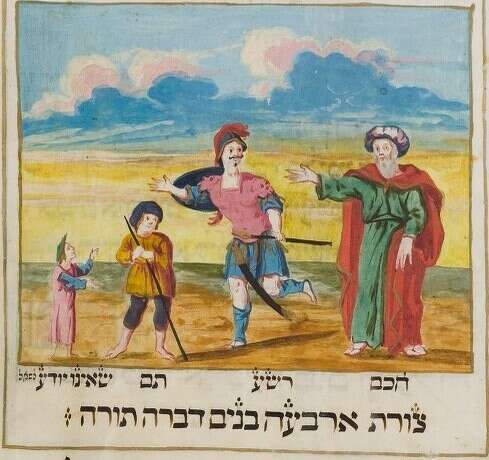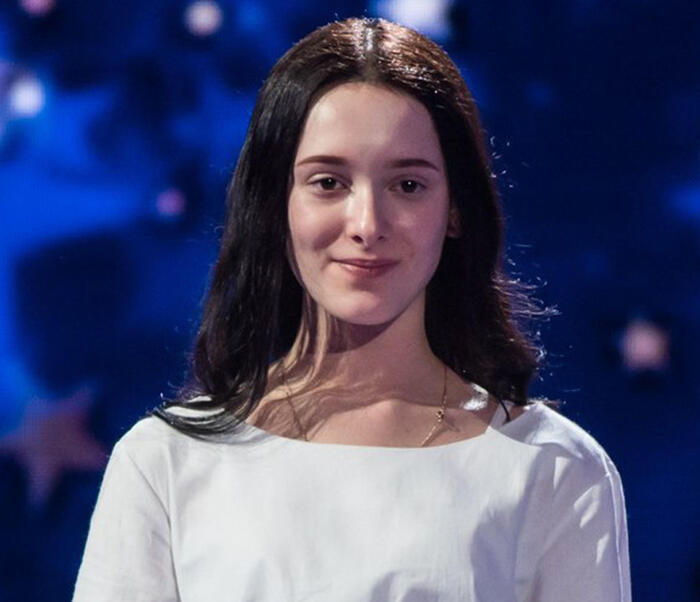Parents must have sung songs for their children since the dawn of history, but Had Gadia is perhaps the first song specially printed for children • An Enlightened Fellow of the National Library dived into the investigation
In general, the Passover Haggadah is a rather obscure text for most of its modern secular readers, who are not well versed in the Midrashic style of our scholars' memory of blessing. Easy to read, and the signature of the text that accompanies one of the major Jewish calendar poetry holidays is not clear about Capricorn - it is a puzzling decision. Perhaps the answer to his existence there lies in the well-being of those who are also responsible for opening the Passover Seder and the difficulty of the difficulties - the children.
Detail from the Passover Haggadah, the ancient Nathan Ben Samson of Mazrich, 1730. From the Berginsky Collection of Hebrew Manuscripts, Zurich, Switzerland
The purpose of the Haggadah is to fulfill the important commandment "and you have betrayed your son" (and we will also add to your daughter) the story of the Exodus. Therefore, the young boys and girls are at the center of the Passover Seder facilities. They are the ones who ask what are the strange customs of this evening, which they divide into categories with the help of four sons, and they are the ones who go out to look for the Afikomen and keep an eye out for the coming of Elijah the Prophet. The Haggadah is full of aids aimed at keeping the youth of the participants in alertness, and this is probably also the song at the end of the Haggadah, which stars animals and wonders.
This is why some scholars have crowned Had Gadya with the crown of the first known children's poem - or at least one of the first. We have no information about songs that parents sang to their children over the course of tens of thousands of years of human history and have not been written - there must have been many. But in the case of Had Gadya, we probably encounter, for the first time, a poem written and printed specifically for children and for their education - a children's song.
Although you know the song by heart, it is probably already buzzing, and yet, let's take a look at the characteristics of this strange song. The song is a cluster song - one in which every new element joins a new component. You must know songs of this kind; Such is, for example, the story "Eliezer and the Carrot" by Levin Kipnis, the song "Uncle Moshe had a farm", and also the "brother" of Had Gadia previous to him in the Haggadah, "One who knows." This structure is especially popular with children who enjoy the repetition and familiar refrain. What else can be learned from easy reading of the poem? Although his language looks like Aramaic, this language does not appear to be spoken by the author or author. The poem is full of grammatical errors and embedded in Hebrew words, so that the Aramaic guess could no longer be spoken language in those days.
This is also perhaps a clue as to when the song was written. The poem's appearance in the Passover Haggadah dates to the 15th or 16th century, and its earlier versions may have been written as early as the 14th century. In print he first appeared in the Prague Haggadah printed in the 16th century. A manuscript was found in a previous version of the piyut, which was subsequently added to the arrangement from the Provence community in France. It differs in some parts of the wording we sing today (in some of the other wordings found in the French region, the poem also appears in the poem, for example), and is also impeccably written in Aramaic. It is estimated that Jews who fled France after the expulsion of Great France (in 1306) brought with them the Piyyut into Ashkenazi communities, with whom he made his way to the Haggadah. Only after that did the song also reach the Haggadahs of the Spanish and Eastern communities.
But what is the origin of the piyut? Are the motifs present in it a Jewish invention? As befits an ancient folk song, we have no definitive answer to this question. Similar motifs are found in a long line of songs from around the world. In his article on "Mon-Gadia", Uriel Ofek mentions the existence of such motifs in stories from Japan, through Greece to South America. In European languages you can find some similar tales in Russian, French and also some German-language versions that use the "One-Gadia" formula. While one of the early German formulas looks like an accurate translation of the Aramaic Piyut, the Grimm Brothers fairy tale collection features a song called "The Pear Does Not Want to Fall." In this song, the landowner sends a peasant child named Yukel to a pear boy from the tree. Yukel refuses, followed by a dog who is asked to bite him - and refuses. Then the stick, the water, the bull, and the slaughterer are sent, and everyone refuses to carry out their task until the threatening executioner arrives which causes the chain to start operating. Those interested can read more about this intriguing song here.
In English you can find the work "The House That Jack Built". In this song the chain begins with the barley found in Jack's house. The characters in the song are more radically different, and the chain goes on with a mouse, a cat, a dog, a cow with horns, a lonely maiden, a man dressed in tears, a shaved priest, a rooster and a farmer. Not everyone eats each other, but there were already scholars who insisted on the connection between the songs and claimed the origin of the song about Jack the Jewish clothing. As mentioned, there is no way to determine for sure "who started". Uriel Ofek speculates in the same article mentioned above that "there may not be too much of an assertion that there is hardly a nation and a language that will not find a fairy tale, a chorus, a rhyme and its actions with" one-sided "form and / or content."
Over the years, Jewish scholars have not satisfied themselves with the existence of her kind acts in the Passover Haggadah, a story whose sole purpose is to entertain the children, and the text has been loaded with interpretive barbed wire. To a chain that can be called simply amiable amusement, theological significance can be given of the place and the role of the Blessed One in the world. One commentary, for example, suggests that the Jedi is a symbol of the Jewish people, and the other figures are the nations that harassed him: Assyria, Babylon, Persia, Greece, Rome, the Muslims, the Crusaders and the Turks. Finally, the Holy One will come and bless him and redeem Israel.
Lots of words were written about this intriguing song, beginning with one garment and ending with a Passover Haggadah. The mysterious piyyut has caught the attention of piyyut and folklore scholars over the years, and they have tried to find the origin of the pyyut and its connection to similar folk songs in different languages. Maybe this time around the Passover table you can also tell something about the song which is - maybe - the first children's song.
A small addition to the finish
We have not forgotten that a song similar to its structure appears before Had Gadia, and it is also intended for the enjoyment of children, and certainly for their education. The story of "One Who Knows" requires a separate article, but it is told here that it also first appeared in print in the same 16th century Prague Haggadah, and also about a writer who was known in Europe perhaps from the 15th century. "One Who Knows" also has parallels in European languages, but unlike "One-Gadia", it has reached the communities of Spain and Portugal and even the Cochin community in India. Hence the question of its origin is even more complicated - and that will be told in the future.
Amit Naor, a member of the National Library, is a lover of history in general and Israeli history in particular. Interested in almost everything about pop culture, politics and sports. Married to Ma'in and father to Itamar. His biggest critic is Juno the cat.















